Does Iran Celebrate Ramadhan 2024?
Ramadhan is one of the five pillars of Islam, besides the declaration of faith(Tawheed); praying five times a day; alms-giving (zakat); and the pilgrimage to Mecca (Hajj).
It is the ninth month in the Islamic lunar calendar during which Muslims worldwide cease drinking, eating or even smoking from sunrise until sundown.
Muslims believe Ramadhan to be a significant month for the revelations of God to humanity, given the belief that it was during the month of Ramadan that the first few verses of the Holy Qur'an were revealed upon Prophet Muhammad (PBUH).
Traveling to Iran in Ramadan 2023
During this month, Muslims fast as an effective way of exercising self-discipline. They are also anticipated to strengthen their character through self-restraint, charitable giving, and introspection to make the rich or fortunate ones experience the suffering of the less unfortunate. Empathize with the poor and the needy, and learn to appreciate God's blessings in their lives. Sharing food with the poor, inviting people for the meal that breaks the fast (iftâr), giving to charity, and completing a reading of the whole Quran during this month attract numerous divine rewards.
Fasting is one of the main rituals in Islam. It is obligatory(farz) for all Muslims except for the sick, pregnant women, and some travellers. In all cases, once health is restored or travelling has ended, one should make up for these missing days by fasting (for the same number of days). At the end of the day, Muslims break their day-long fast with an "iftar" meal.
This practice is observed for the whole month and ends with celebrating Eid-ul- Fitr'.
Ramadhan in Iran

Iran is an Islamic country. A large portion of the population is Muslim, which means Ramadhan has a massive impact on society all around the country. Most people in Iran decorate their shops or streets with lights and flowers, and they will congratulate fellow Muslims by saying 'Ramadhan Mubarak' (blessed Ramadhan).
In Ramadhan, people wake up early before dawn to have a pre-fast breakfast, called "Sehari" in Persian. The meal is usually light and consists typically of previously prepared foods. The more elaborate meal, Iftar, comes at the end of the fasting day. Iftar, if possible, is consumed with close members of the family, relatives, friends and neighbours. Mosques become more cheerful during the holy month of Ramadhan. Volunteers with the intention to perform acts of charity distribute food, clothes and Iftar in mosques to people as votives.
Food Traditions During Ramadan
Fantastic stews, sweets, fresh dates, and traditional Azari cheese with vegetables and nuts, along with a glass of tea to wash them down, is very common on any dinner table in Iran, especially during Ramadhan.
Although there is no defined food for the meals in Ramadhan, Iranians have some unique cuisines, some of which may not find in any other month of the year.
- Zulbia Bamiyeh
 The sticky and crispy Zulbia and tasty fluffy Bamiyeh, the most popular Ramadan sweets, are the Persian version of crispy doughnuts that dates back to the time of Nasser al-Din Shah Qajar. You cannot forget the sweetest memory, Crispy on the outside, soft on the inside of them after eating!
The sticky and crispy Zulbia and tasty fluffy Bamiyeh, the most popular Ramadan sweets, are the Persian version of crispy doughnuts that dates back to the time of Nasser al-Din Shah Qajar. You cannot forget the sweetest memory, Crispy on the outside, soft on the inside of them after eating!
These two traditional sweets, made of deep-fried dough dunked in tasty syrup, are associated with the sun and light. The reason for the emergence of such delicious sweets was that in some cities of Iran, sweets such as raisins and dates were unavailable in the past. They were not cultivated due to weather conditions. Transporting these materials to other cities also caused many problems, which led to the gradual invention of Zulbia and Bamiyeh. These tasty sweets spread in cities that did not have much fruit or nuts. This delicacy was so popular that it was brought to kings as a gift 150 years ago.
- Halim
Is a very famous food in Middle Eastern countries. It comprises shredded meat (beef, lamb, chicken or turkey), barley, wheat and some spices. This dish is simmered for more than 8 hours, which results in a thick paste-like consistency, blending the flavours of spices, meat, barley, and wheat. Iranian people serve Halim as breakfast on regular days. But in Ramadan, Halim is also a delicacy on the Iftar table.
- Ash Reshteh
Ash Reshteh is the most traditional Persian stew dish and has hundreds of versions cooked in different parts of Iran. It is a thick mixture of vegetables, Persian noodles, fried onion, fried garlic, fried dried mint powder, beans, etc. Iranians also add some Kashk, a salty dairy sauce of dried yoghurt, which makes Ash Reshteh more savoury.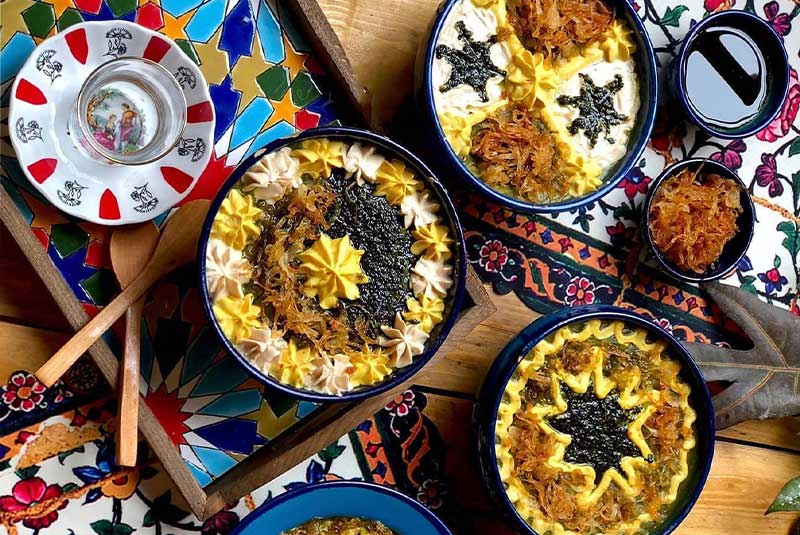
- Dates or Stuffed Dates
For thousands of years, date fruits have been the staple food of the Middle East and India. They are rich in antioxidants and fibre and have a lot of potassium. In addition, the consumption of dates during Ramadhan is very useful in regulating blood sugar, so eating 3-5 dates at the Iftar meal is recommended. According to some research, in the last hours of fasting, blood sugar drops and affects the brain, causing a person to feel bored and weak, and the fasting person's concentration decreases. Iranians stuff dates with walnuts and a sprinkle of coconut powder on its top, which makes it interesting!
- Persian Halva
The Persian Halva is a famous Iranian sweet almost always served at an Iranian funeral and during Ramadan. Flour, along with oil, sugar, cardamom, and rose, are the main items of this Iranian dessert. Its colour varies from light golden to dark brown, depending on the type of baking.
- Sholeh Zard
Sholeh Zard is a Persian rice pudding with delicate mild sweetness. Iranians make it with saffron, rose water, pistachios, cinnamon, and almonds in golden colour.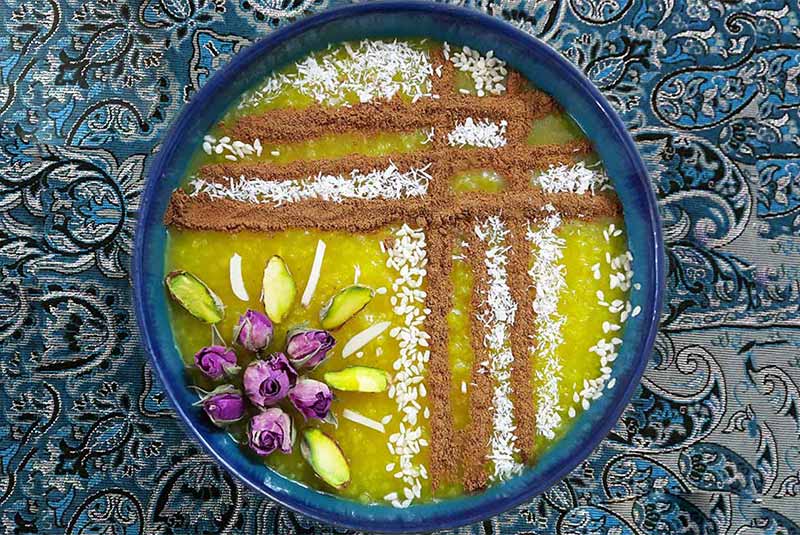
Communal Praying
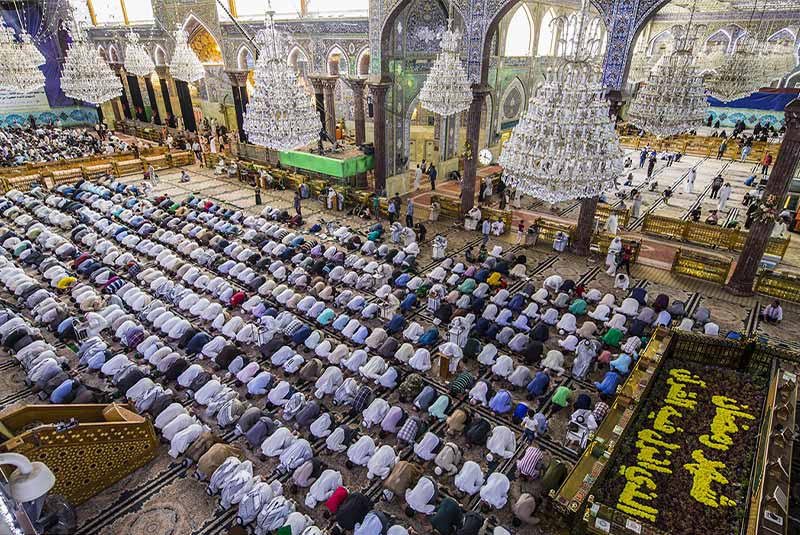
Communal praying, recitations of the entire Quran, and preaching by religious figures and other respected authorities are among the common ceremonies held during this month.
The last ten days of Ramadhan are significant because the Holy Quran was revealed upon Prophet during these days at the Night of Decree (Laylatul-Qadr)
According to the Quran, Laylatul-Qadr is better than a thousand nights. Some people will retreat into prayers during these last ten days. These days of it-tikaf or retreat ends with the festival Eid-ul- Fitr. All the mosques, as well as the holy shrines across Iran, host the people who want to take part in i-tikaf. They also provide pre-fast breakfast (Sehari) and Iftar. Many people even stay in mosques for three days to perform their religious rituals.
Martyrdom of Imam Ali
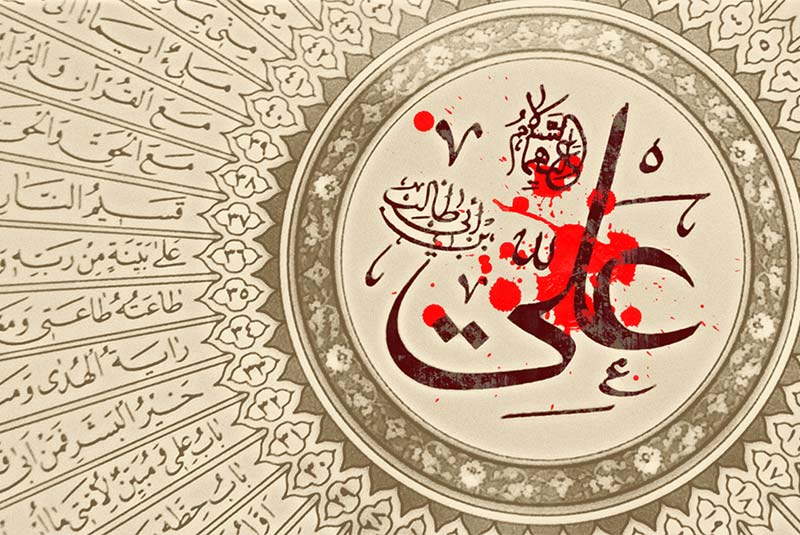
19th and 21st of Ramadhan observed as the days of the assassination which led to the martyrdom of Imam Ali – the first Imam in Shias – are mourned by Iranians throughout the country. Over these nights, many religious groups start memorial ceremonies to pay respects on their behalf to Imam Ali and mourn his brutal assassination.
People stay up all night praying, reciting special duas and, at times, will hold the Quran on their heads while praying.
Religious rituals throughout the country make Ramadhan in Iran more unique and memorable. Thousands of Black-clad chest-beating local participants swarm the cities of Iran during the 21st of Ramadhan. At the same time, religious street theatres, free food givers, and traditional Persian drinks (lemonade-like) on tables decorate the streets of every city.
Martyrdom is very important in Iranian Shia culture, and Imam Ali's assassination and martyrdom are mourned intensely by Iranians. According to Shia beliefs, when the Prophet passed away, the leadership of the Muslim community was passed on to Imam Ali, his cousin and son-in-law.
Here are some of the rituals which Iranians do in Iran to celebrate the holy month of Ramadhan:
Eid-ul-Fitr
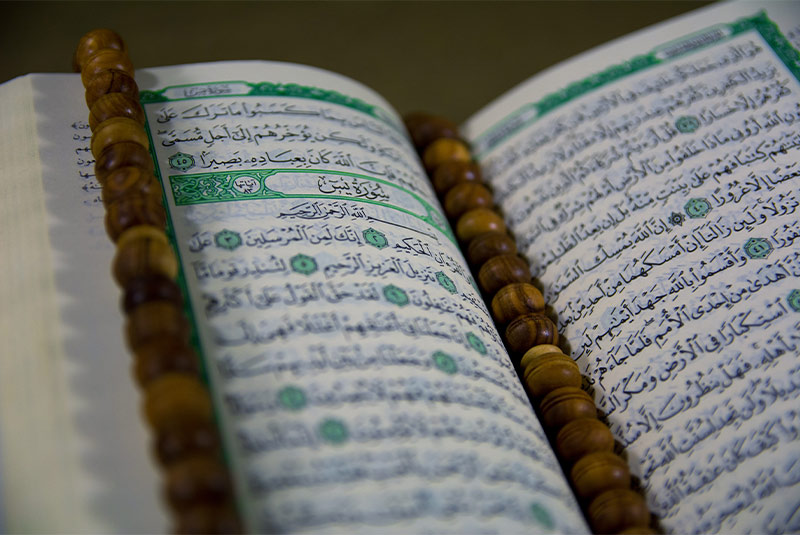
Eid-ul-Fitr marks the beginning new lunar month of Shawwal. It's a 2-day celebration and festival as fasting days, and holy Ramadan ends. This day is truly remarkable as everyone and everything changes. The occasion is celebrated with a massive feast. Suddenly there are lots of food everywhere. Food sharing and family reunions create an absolutely joyful atmosphere all around the country. The last Iftar is more elaborate and often joined by family, friends and neighbours.
This day begins with a solemn prayer called Salat al-Eid. The majority of people attend their local mosques for communal prayers. Prominent religious figures and Marja usually lead the prayers.
It's an official holiday throughout the country. The extra day off work means many people plan to go on a trip, especially if Eid is at the end or the start of the week. It's an official holiday, meaning shops, museums, etc., are closed.


Comment
Leave a Comment